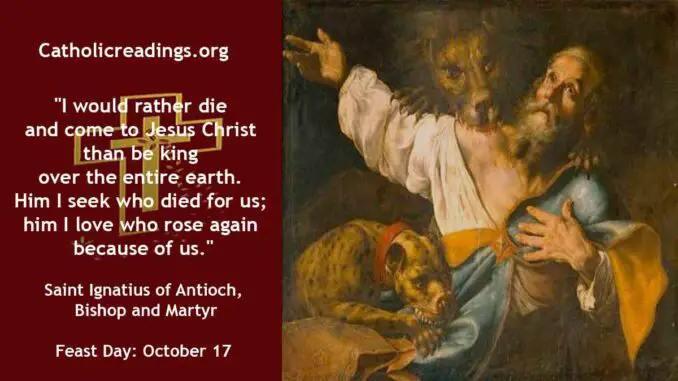St Ignatius was the Bishop of Antioch who was born in Syria.
He died as a martyr in 107 AD in Rome during the persecutions of Christians by Emperor Trajan in Antioch.
We celebrate his feast day on October 17 every year in the Catholic Church.
St Ignatius of Antioch is the Patron Saint of the Church in the Eastern Mediterranean and the Church in North Africa
| Saint Ignatius of Antioch, Bishop and Martyr Biography | |
|---|---|
 |
|
| Date of Birth | 1st-century |
| Place of Birth | Syria |
| Profession | An early Christian writer and Bishop of Antioch |
| Place of Work | Antioch |
| Date of Death | 107 AD |
| Place of Death | Rome, Roman Empire |
| Feast Day | October 17 |
| Canonization | Pre-Congregation |
| Patron Saint of | 1. Church in Eastern Mediterranean 2. Church in North Africa |
St Ignatius of Antioch Life History
St. Ignatius of Antioch converted to Christianity at an early age and was friends with St. Polycarp. Both of them were disciples of St John the Apostle.
Later on, he was chosen to become the Bishop of Antioch, (this is the city where the disciples were first called Christians) and used to call himself God-Bearer (Theophorus).
Roman Emperor Trajan continued prosecuting Christians around the Roman Empire including Antioch. St Ignatius was not killed in Antioch and was taken to Rome by ten soldiers for persecution.
Instead of being transported directly by sea, the soldiers took him around the towns and cities of Asia Minor and Greece where he met with other Christians before finally reaching Rome.
In this long trek, Ignatius wrote seven letters to the Christians. The seven epistles are;
- The Epistle to the Trallians,
- The Epistle to the Smyrnaeans,
- The Epistle to the Romans,
- The Epistle to the Philadelphians,
- The Epistle to the Magnesians,
- The Epistle to the Ephesians,
- The Epistle to Polycarp, a bishop of Smyrna.
In these letters, St Ignatius urged the Christians there to continue being faithful to God and to remain obedient to their Church leaders. He also warned them against heresies.
These letters show the behaviour and demeanour of the early Christians and also show that what St Ignatius believed in the 1st Century is what we Catholics believe today.
St Ignatius postulated that we should celebrate the day of the Resurrection of our Lord Jesus Christ as a festival because on that day our life germinated again and we obtained through Christ the victory over death.
To the disciples in Rome, he wrote: “Allow me to emulate my suffering God. I am God’s wheat and I shall be chewed by the teeth of beasts, that I may become the pure bread of Christ.”
He was also a strong proponent of the Holy Eucharist and that Jesus was true God and true man. He believed that Jesus Christ, The Word, was made flesh and came to dwell among us.
St Ignatius wrote, “Wherever the bishop goes, let there be people; just like wherever Jesus Christ is, there is the Catholic Church.” It is St Ignatius who was the first to use the word “Catholic” to refer to the Church.
Death
In Rome, he was mauled by lions and died as a martyr in the year 107 AD.
Relics
After his martyrdom, his remains were taken back to Antioch by his companions but in 637 AD his relics were transferred to The Basilica of Saint Clement in Rome.
St Ignatius of Antioch Feast Day
From the 12th Century until 1969 his feast day was celebrated on February 1, but after the Roman Catholic Church liturgical reforms in 1969, the feast day was transferred to October 17.
St Ignatius of Antioch is the Patron Saint of
- Church in Eastern Mediterranean
- Church in North Africa
St Ignatius of Antioch Quote
“I would rather die and come to Jesus Christ than be king over the entire earth. Him I seek who died for us; him I love who rose again because of us.” – St. Ignatius of Antioch
Other Catholic Saints whose Feast Days are in October
Related Links
Powered By SEO Experts
Follow @ReadingCatholic
